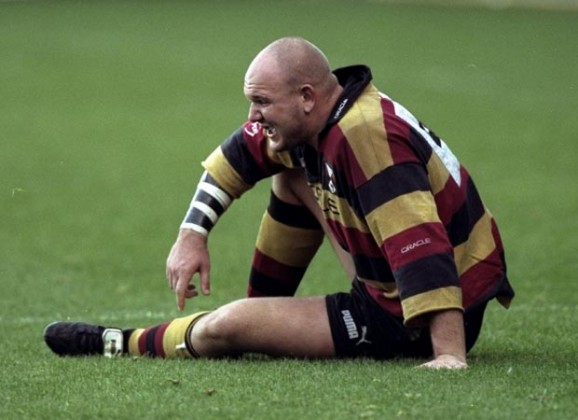 Relegation is a fact of life in any sport with leagues, or at least should if that league structure is to retain its long term integrity. For every meteoric rise there has to be a club heading the other way and there have been a few casualties along the way since the RFU went down that route 27 years ago with the Courage First Division and then the Premiership in its various incarnations – Courage, Allied Dunbar, Guinness and now Aviva.
Relegation is a fact of life in any sport with leagues, or at least should if that league structure is to retain its long term integrity. For every meteoric rise there has to be a club heading the other way and there have been a few casualties along the way since the RFU went down that route 27 years ago with the Courage First Division and then the Premiership in its various incarnations – Courage, Allied Dunbar, Guinness and now Aviva.
Since 1987 there have been eight clubs who, having been relegated or temporarily wound up, have never made it back to the top tier of the English game.
Well, not yet anyway, although some still haven’t thrown in the towel. And that doesn’t take into account the likes of West Hartlepool and Liverpool St Helens who yoyo-ed between the leagues for a while before virtually slipping off the radar.
Of the eight I list, all suffered, one way or another, from both the demands of league rugby and then the decision in August 1995 to declare rugby open while for some there was definitely an element of bad timing and luck. Strong historic clubs who just happened to be experiencing a rare dip in fortunes at the wrong time. Five years earlier or five years later they would probably have weathered the storm and found a way of flourishing.
Coventry probably come under that banner, a giant of English rugby historically and a strong vibrant team full of stars during the Sixties, Seventies and early Eighties. But by the time the Courage National League started in earnest in 1987, however, they were enduring a dip and down they went. Perhaps it didn’t seem too important at the time?
Some may have felt leagues would have a short shelf life. It is interesting to note that clubs arranged the league fixtures informally among themselves that first season and that champions Leicester never actually got around to facing Gloucester while Bristol and Waterloo also neglected to play each other. Unthinkable these days. Very soon ‘Cov’ – of all clubs – were deep in the mire, caught in that vicious spiralling circle of decline that many other were to experience: falling gates, escalating costs during professionalism’s early days, short term financial fixes, promises of long term solvency, bankruptcy, receivership, the selling off of a much loved ground, the reluctant necessity to make a home elsewhere and that sinking feeling that the rest of the rugby world has just disappeared over the horizon.

Just once did Coventry seriously threaten a serious revival, in the 1996-97 season when a young Danny Grewcock, the canny Derek Eves and the underrated Julian Horribin spearheaded a hard nosed team that finished third in National 1. On one memorable misty evening at Coundon Road, in front of a record 9,000 strong crowd, they rolled back the years and sent Sir John Hall’s star-studded team back to Newcastle with a bloody nose, the Falcons only defeat of the season. The last gasp of a once mighty rugby beast?
It was a privilege to be present that evening for a glimpse at past glories and what might have been. It was a first and last visit for me, an immensely atmospheric ground with an industrial ambience – next door was the London Taxis International factory where just about every black cab on the planet first saw the light of day. It was unmistakably the ‘Midlands’ from the pie and pint in the Coundon Pub and the ghosts of Peter Jackson, Peter Preece, David Duckham et al that seemed to haunt the place.
But even then I remember thinking it might all be on borrowed time. It was a “walk-up” ground with almost no provision made for parking – if the club faltered and lost its standing locally all would be lost. And it very nearly was. Cov had to sell the ground – it’s a housing estate now, but somehow they have kept going and they have morphed into a perfectly respectable and national leagues outfit. But the glory days have surely gone.
The Reddings was another famous ground that has ended up as a housing estate with its former owners Moseley RFC eventually needing to decamp elsewhere as they encountered hard times. As a case study Moseley share much with Coventry – pillars of the English game as recently as the Seventies but, alas, clubs with the turning circle of the QE2. They just couldn’t adapt to leagues quickly enough when the moment came. And they paid a huge price.
Moseley fought the good fight for four seasons before bailing out of the top flight, never to be seen again at that level.
They are a stubborn bunch, though, and have survived all sorts of financial problems and a gut-wrenching switch of grounds and there were moments of real promise in their Championship campaign last year. The club is ticking over nicely at one level but in truth they are in no position to aspire to Premiership rugby again at present, either financially or in terms of the ground criteria.
They are in a state of flux working very hard to retain the status quo while also looking to the skies and praying for something wondrous to happen or a sugar daddy to miraculously appear.

Yet another old Premiership ground that “disappeared” was Nottingham’s Ireland Road in Beeston. In fact you sometimes wonder if property developers nationwide didn’t spend half their time looking through the RFU handbook scouting out the next victims.
Nottingham were a more than useful outfit in the early days but lost a succession of top players – Rob Andrew, Brian Moore, Simon Hodgkinson, Chris Gray, Chris Oti – and just once in five seasons found themselves in relegation difficulty. That’s all it took, however, in 1992, and since then it has been a mighty struggle with the sale of Beeston aiding in their survival. Like Moseley, though, they have kept their head above water and all the time they can retain their Championship status they at least have a ticket in the raffle to speak. Nottingham have relocated to Meadow Lane so should they ever earn promotion through the play-offs they would at least be in a position to accept a place into the modern day Premiership.
Perhaps the biggest fall from grace – although that’s too harsh a term for a club that were really no more than victims of circumstance – was that of Orrell who went into freefall in 1997 after nearly a decade of being a considerable force in England‘s early elite leagues and boasting players such as future Lion Austin Healey. Cruelly they now play their trade in lowly South Lancs/Cheshire 2.
Somehow you always feared for Orrell, an incongruous Union outpost in a League heartland near Wigan with no natural constituency in terms of crowd, and indeed players, as Lancashire ceased to be the Union hotbed it once was. They seemed to come from nowhere and flourish on sheer guts and spirit. And when that was exhausted what was left? Their decline was a car crash in slow motion, with by-standers unable to step in change the course of events. Their fortress Edge Hall Road is another to bite the dust, sold by Dave Whelan in 2004.
Richmond FC and Rugby – two of the most resonant names in the sport – both had to start at rock bottom when they eventually fell off the cliff. For Richmond it was a very sudden process after two reasonably successful seasons in the Premiership when Ashley Levett suddenly withdrew his financial support for an operation that had included big-name recruits such as Wales lock Craig Quinnell. They were put into administration. A thunderously black day for one of the best connected and most “establishment” clubs then imaginable but their response had been exceptional as they have fought their way up through the leagues, at one stage reeling off an English club record of 83 straight wins.
They now reside in National 1 and there might come a moment a few years down the line when they need to ask themselves whether they want to seriously contemplate the prospect of Premiership rugby again.
Rugby Lions have led a chequered history since their time as a Premiership club but somehow they had managed to keep the wolf from the door until two years ago, ironically after a highly successful season. They had massively overstepped themselves financially, went into liquidation and were effectively suspended for a year before and like Richmond asked to start again at the very bottom. It’s too early yet to see if they can do a Richmond and successfully climb the greasy ladder again. As a little hat-tip to the past, though, Rugby are still one of only three teams in England allowed to wear all-white – England and Rugby School being the others.
Which leaves Rosslyn Park and Waterloo, stalwarts of the old amateur era. Park are a very particular case who took the decision once they went down and failed to bounce back the next season to not ruin the club by pursuing the impossible dream. They doggedly remained amateur and recruited players who were not willing to chase a career as a professional rugby player. Wherever that took them, that’s where Park would play their rugby. Interestingly that approach took them to a rather unlucky runners-up sport in National 1 last season. Had they been blessed with promotion they also would have to need to think long and hard about how to compete with the likes of Worcester, Bristol, Leeds and their south London neighbours London Scottish who have also miraculously clawed their way back up the ladder.
Waterloo took a mix and match approach for a while and try to run a professional squad but the finances just didn’t appear and have now taken a similar approach, finding their natural level before trying to build again.
*This article was first published in The Rugby Paper on August 31.
























Pingback: agent frigorific
Pingback: บับเบิ้ล กันกระแทก